The Size Effects of Point Defect on the Mechanical Properties of Monocrystalline Silicon: A Molecular Dynamics Study
Abstract
:1. Introduction
2. Model and Methods
3. Results
3.1. The Size Effects of Point Defect on Mechanical Performance
3.2. Discussing the Mechanism of Strength Reduction from Stress Variation
3.3. Dynamic Evolutions of Dislocations in Fracture Process
3.4. Fractured Microstructures of Monocrystalline Silicon
4. Conclusions
Author Contributions
Funding
Institutional Review Board Statement
Informed Consent Statement
Data Availability Statement
Acknowledgments
Conflicts of Interest
References
- Kuo, C.L.; Nien, Y.P.; Chiang, A.C.; Atsushi, H. Surface modification using assisting electrodes in wire electrical discharge machining for silicon wafer preparation. Materials 2021, 14, 1355. [Google Scholar] [CrossRef]
- LeDantec, M.; Abdulstaar, M.; Leparoux, M.; Hoffmann, P. Epitaxial growth of silicon on silicon wafers by direct laser melting. Materials 2020, 13, 4728. [Google Scholar] [CrossRef] [PubMed]
- Liu, B.; Xu, Z.W.; Chen, C.; Li, R.; Gao, X.; Liang, L. Numerical and experimental investigation on ductile deformation and subsurface defects of monocrystalline silicon during nano-scratching. Appl. Surf. Sci. 2020, 528, 147034. [Google Scholar] [CrossRef]
- Li, D.S.; Yang, D.R.; Que, D.L. Progress in study of crystal silicon mechanical properties. Mater. Sci. Eng. 2000, 18, 100–104. [Google Scholar]
- Yonenaga, I.; Sumino, K.; Hoshi, K. Mechanical strength of silicon crystals as a function of the oxygen concentration. J. Appl. Phys. 1984, 56, 2346–2350. [Google Scholar] [CrossRef]
- Sumino, K.; Yonenaga, I. Difference in the mechanical strengths of dislocation-free crystals of Czochralski silicon and Float-zone silicon. Jpn. J. Appl. Phys. 1981, 20, L685–L688. [Google Scholar] [CrossRef]
- Liang, H.; Li, M.S. Molecular dynamics study of mechanical properties of single crystal aluminum with voids and vacancies. Chin. J. Comp. Phys. 2019, 36, 2. [Google Scholar]
- AlMotasem, A.M.; Posselt, M.; Polcar, T. Deformation behavior of nanocrystalline body-centered cubic iron with segregated, foreign interstitial: A molecular dynamics study. Materials 2020, 13, 5351. [Google Scholar] [CrossRef]
- Mishra, N.; Makov, G. Point defects in lead sulfide: A first-principles study. Comput. Mater. Sci. 2021, 190, 110285. [Google Scholar] [CrossRef]
- Gao, X.H.; Yuan, L.; Fu, Y.T.; Yao, X.F.; Yang, H. Prediction of mechanical properties on 3d braided composites with void defects. Compos. Part B 2020, 197, 108164. [Google Scholar] [CrossRef]
- Mahata, A.; Jiang, J.W.; Mahapatra, D.R.; Rabczuk, T. Effect of intrinsic structural defects on mechanical properties of single layer mos2. Nano Struct. Nano Obj. 2019, 18, 100247. [Google Scholar] [CrossRef]
- Fan, L.; Yao, W.J. Effects of vacancy defects on the mechanical properties of graphene/hexagonal bn superlattice nanoribbons. New Carbon Mater. 2020, 35, 165–175. [Google Scholar] [CrossRef]
- Hausherr, J.M.; Wagner, L.; Gorywoda, M. Fabrication of artificial defects and their effect on the mechanical properties of c/c-sic. J. Eur. Ceram. Soc. 2020, 40, 636–641. [Google Scholar] [CrossRef]
- Wu, H.; Melkote, S.N. Effect of crystal defects on mechanical properties relevant to cutting of multicrystalline solar silicon. Mat. Sci. Semicon. Proc. 2013, 16, 1416–1421. [Google Scholar] [CrossRef]
- Menold, T.; Hadjixenophontos, E.; Lawitzki, R.; Schmitz, G.; Ametowobla, M. Crystal defects in monocrystalline silicon induced by spot laser melting. J. Appl. Phys. 2020, 127, 093102. [Google Scholar] [CrossRef]
- Krenckel, P.; Hayama, Y.; Schindler, F.; Trotschler, T.; Riepe, S.; Usami, N. Propagation of crystal defects during directional solidification of silicon via induction of functional defects. Crystals 2021, 11, 90. [Google Scholar] [CrossRef]
- Liu, J.; Yuan, H. The evolution and failure mechanism of lithium metal anode under practical working conditions. J. Energy Chem. 2020, 48, 424–425. [Google Scholar] [CrossRef]
- Darbaniyan, F.; Yan, X.; Sharma, P. An atomistic perspective on the effect of strain rate and lithium fraction on the mechanical behavior of silicon electrodes. J. Appl. Mech. 2019, 87, 1–8. [Google Scholar] [CrossRef] [Green Version]
- Kim, K.H.; Shon, J.; Jeong, H.; Park, H.; Heo, J.S. Improving the cyclability of silicon anodes for lithium-ion batteries using a simple pre-lithiation method. J. Power Sources 2020, 459, 228066. [Google Scholar] [CrossRef]
- Han, J.W.; Tang, D.M.; Kong, D.B.; Chen, F.Q.; Xiao, J.; Zhao, Z.Y.; Pan, S.Y.; Wu, S.C.; Yang, Q.H. A thick yet dense silicon anode with enhanced interface stability in lithium storage evidenced by in situ tem observations. Sci. Bull. 2020, 18, 1563–1569. [Google Scholar] [CrossRef]
- Xie, Q.X.; Qu, S.P.; Zhao, P. A facile fabrication of micro/nano-sized silicon/carbon composite with a honeycomb structure as high-stability anodes for lithium-ion batteries. J. Electroanal. Chem. 2021, 884, 115074. [Google Scholar] [CrossRef]
- Korsós, F.; Roszol, L.; Jay, F.; Veirman, J.; Draoua, D.A.; Albaric, M.; Szarvas, T.; Kiss, Z.; Szabó, A.; Soczó, I.; et al. Efficiency limiting crystal defects in monocrystalline silicon and their characterization in production. Sol. Energy Mater. Sol. C 2018, 186, 217–226. [Google Scholar] [CrossRef]
- Li, L.L.; Feng, R.C.; Li, H.Y.; Kou, P.P.; Yan, F. Effect of vacancy concentration on yield strength of γ-tial alloy. J. Mater. Sci. Eng. 2020, 38, 1. [Google Scholar]
- Berendsen, H.J.C.; Postma, J.P.M.; VanGunsteren, W.F.; DiNola, A.; Haak, J.R. Molecular dynamics with coupling to an external bath. J. Chem. Phys. 1984, 81, 3684–3690. [Google Scholar] [CrossRef] [Green Version]
- Stukowski, A. Visualization and analysis of atomistic simulation data with ovito–the open visualization tool. Model. Simul. Mater. Sci. Eng. 2010, 18, 015012. [Google Scholar] [CrossRef]
- Tersoff, J. New empirical model for the structural properties of silicon. Phys. Rev. Lett. 1986, 56, 632–635. [Google Scholar] [CrossRef] [PubMed]
- Tersoff, J. Empirical interatomic potential for silicon with improved elastic properties. Phys. Rev. B 1988, 38, 9902–9905. [Google Scholar] [CrossRef] [PubMed]
- Tersoff, J. Modeling solid-state chemistry: Interatomic potentials for multicomponent systems. Phys. Rev. B 1989, 39, 5566–5568. [Google Scholar] [CrossRef]
- Balamane, H.; Halicioglu, T.; Tiller, W.A. Comparative study of silicon empirical interatomic potentials. Phys. Rev. B 1992, 46, 2250–2279. [Google Scholar] [CrossRef]
- Zhou, N.G.; Hu, Q.F.; Xu, W.X.; Li, K.; Zhou, L. A comparative study of different potentials for molecular dynamics simulations of melting process of silicon. Acta Phys. Sin. 2013, 62, 146401. [Google Scholar]
- Xiao, S.B.; Wang, W.; Liu, T.Y.; Zhang, Q.; Lu, Z.Q. Effects of vacancies and c atoms on mechanical properties of fe grain boundary. Iron Steel 2020, 55, 75–81. [Google Scholar]
- Bullegas, G.; Lamela, J.M.; Pimenta, S.; Pinho, S.T. On the role of dynamic stress concentrations and fracture mechanics in the longitudinal tensile failure of fibre-reinforced composites. Eng. Fract. Mech. 2020, 228, 106920. [Google Scholar] [CrossRef]
- Alfirevic, I. General tensor approach to strength theories and yield criteria in isotropic materials. Strojarstvo 1992, 34, 5–7. [Google Scholar]
- Gong, L.G.; Xiong, Y.J.; Zhang, B.H.; Chen, Z.X.; Yang, G.J. Gongcheng Lixue, 1st ed.; BeiHang University Press: Beijing, China, 2010; pp. 156–157. [Google Scholar]
- Tan, S.C. A new approach of three-dimensional strength theory for anisotropic materials. Int. J. Fracture 1990, 45, 35–50. [Google Scholar] [CrossRef]
- Batdorf, S.B.; Ghaffarian, R. Size effect and strength variability of unidirectional composites. Int. J. Fracture 1984, 26, 113–123. [Google Scholar] [CrossRef]
- Wei, W.; Yang, Q.S.; Liang, J.C.; Guo, S.J.; Ma, L.H. Theory and calculation of the mixed-mode fracture for coupled chemo-mechanical fracture mechanics. Theor. Appl. Fract. Mech. 2021, 112, 102817. [Google Scholar] [CrossRef]
- Yonenaga, I.; Sumino, K. Dislocation dynamics in the plastic deformation of silicon crystals I. Experiments. Phys. Stat. Sol. 1978, 50, 685–693. [Google Scholar] [CrossRef]
- Suezawa, M.; Sumino, K.; Yonenaga, I. Dislocation dynamics in the plastic deformation of silicon crystals II. Theoretical analysis of experiment results. Phys. Status Solidi 1979, 51, 217–226. [Google Scholar] [CrossRef]
- Chen, H.; Levitas, V.I.; Xiong, L.M.; Zhang, X.C. Stationary dislocation motion at stresses significantly below the Peierls stress: Example of shuffle screw and 60 degrees dislocations in silicon. Acta Mater. 2021, 206, 116623. [Google Scholar] [CrossRef]

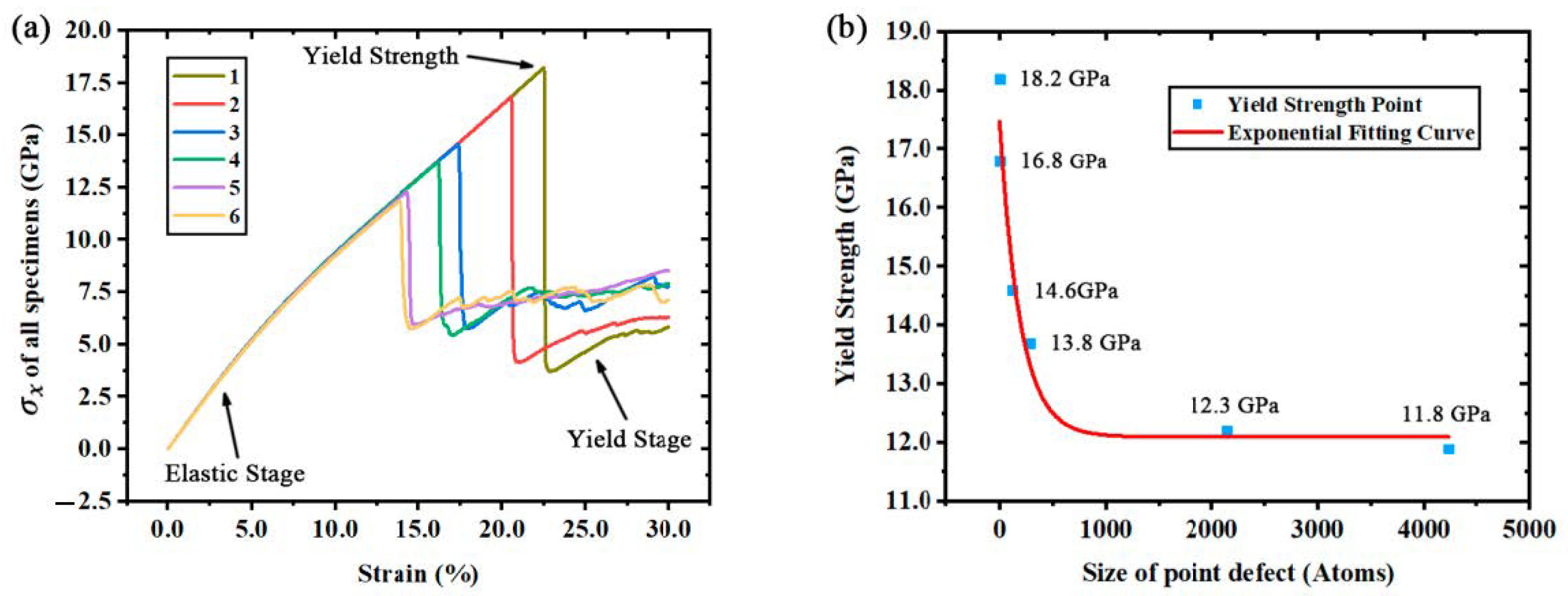
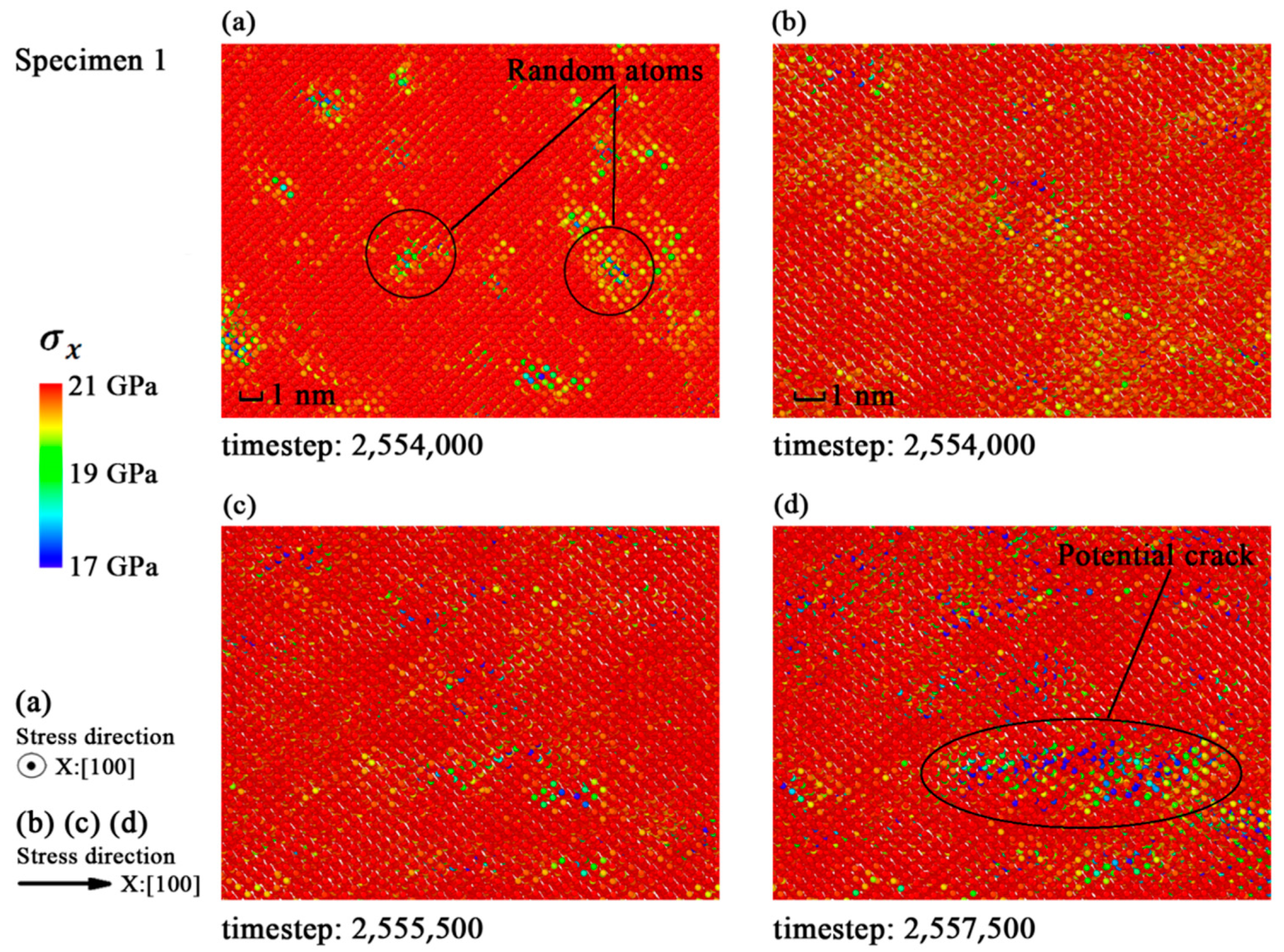
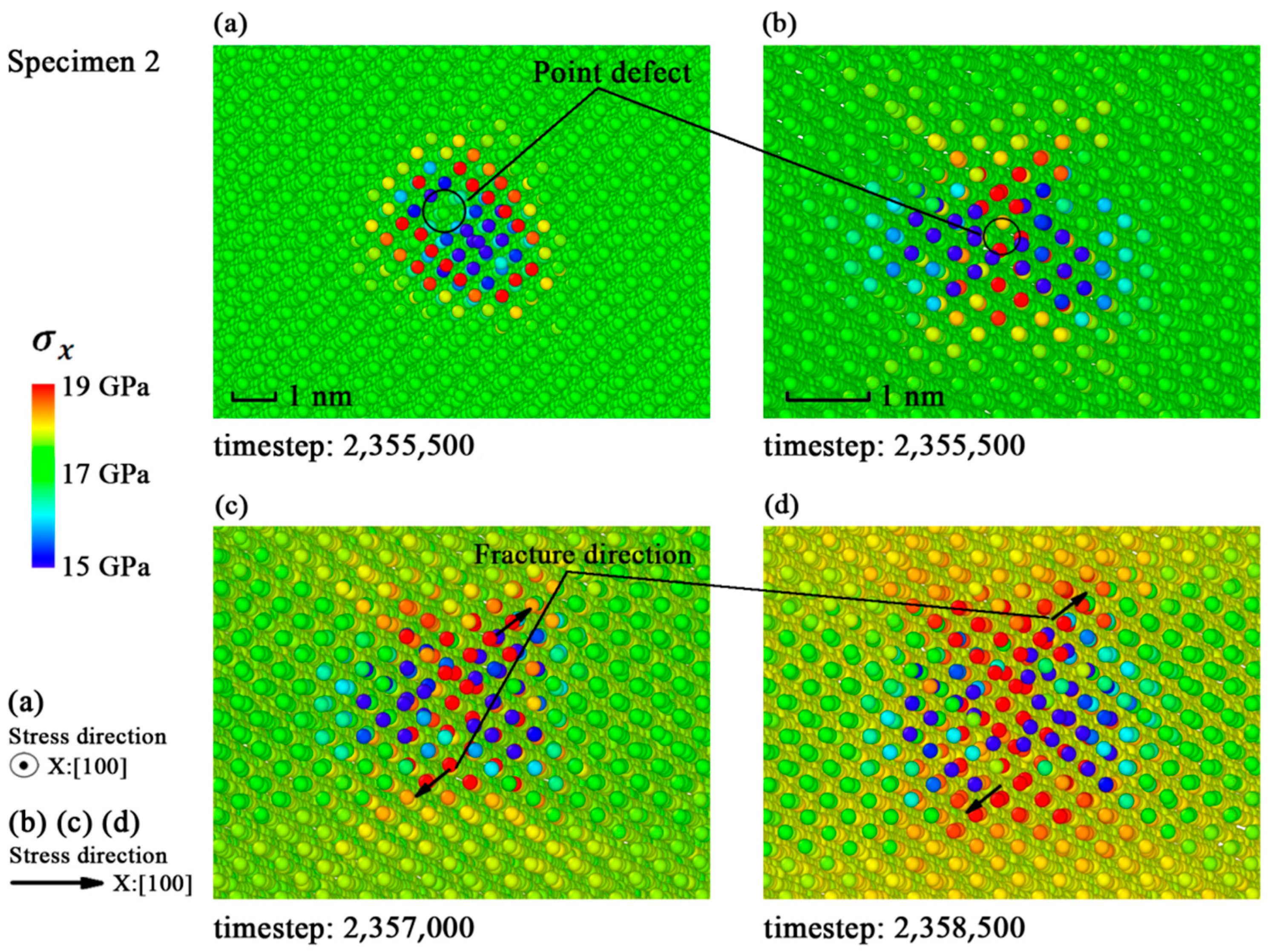

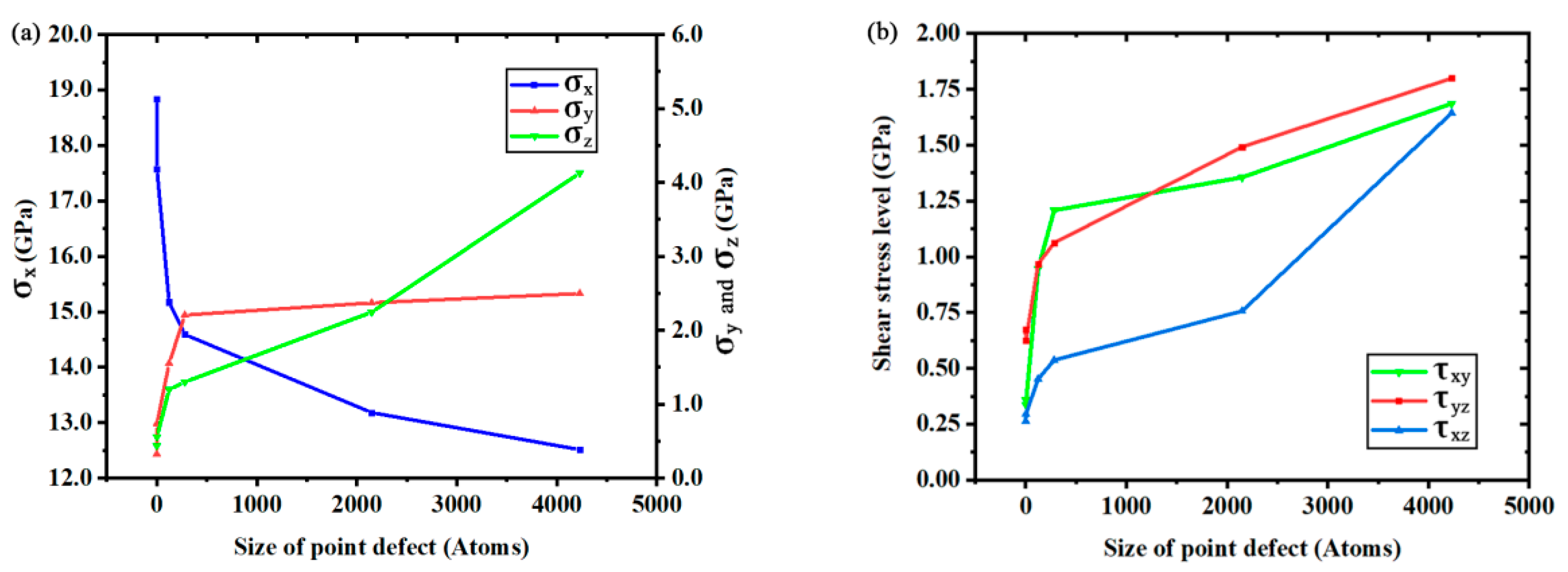

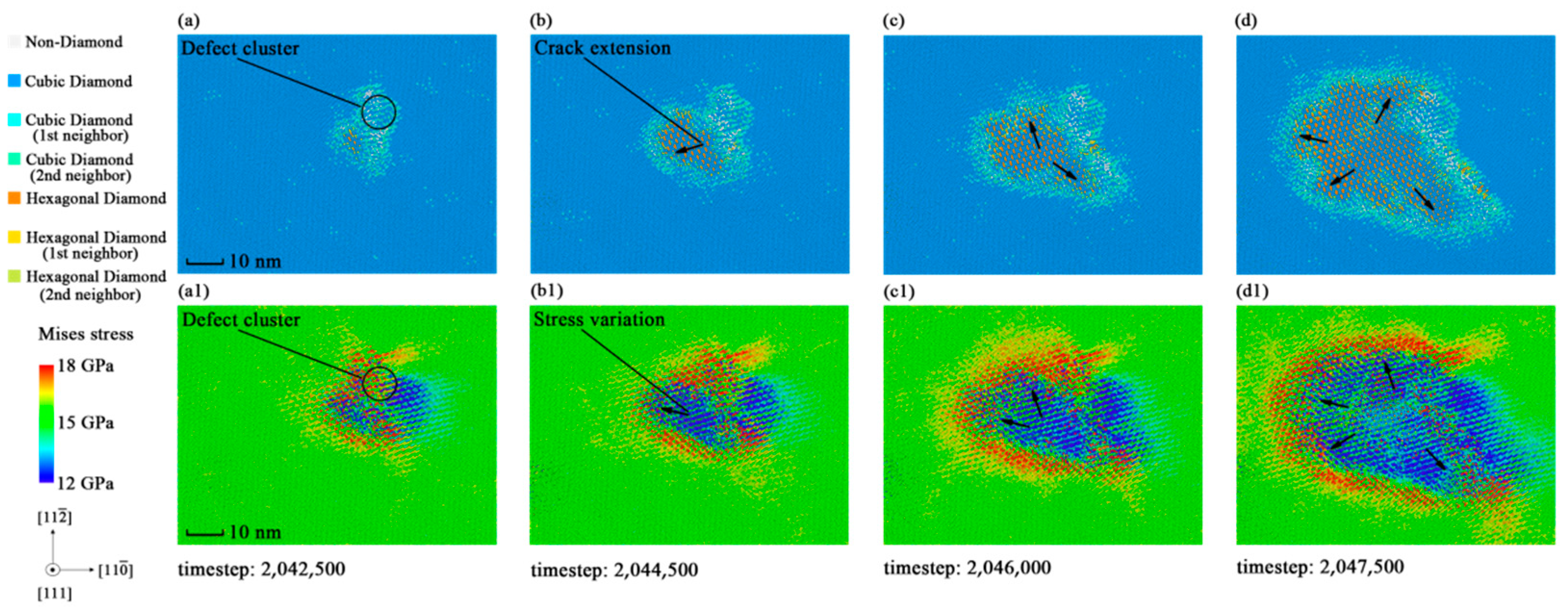


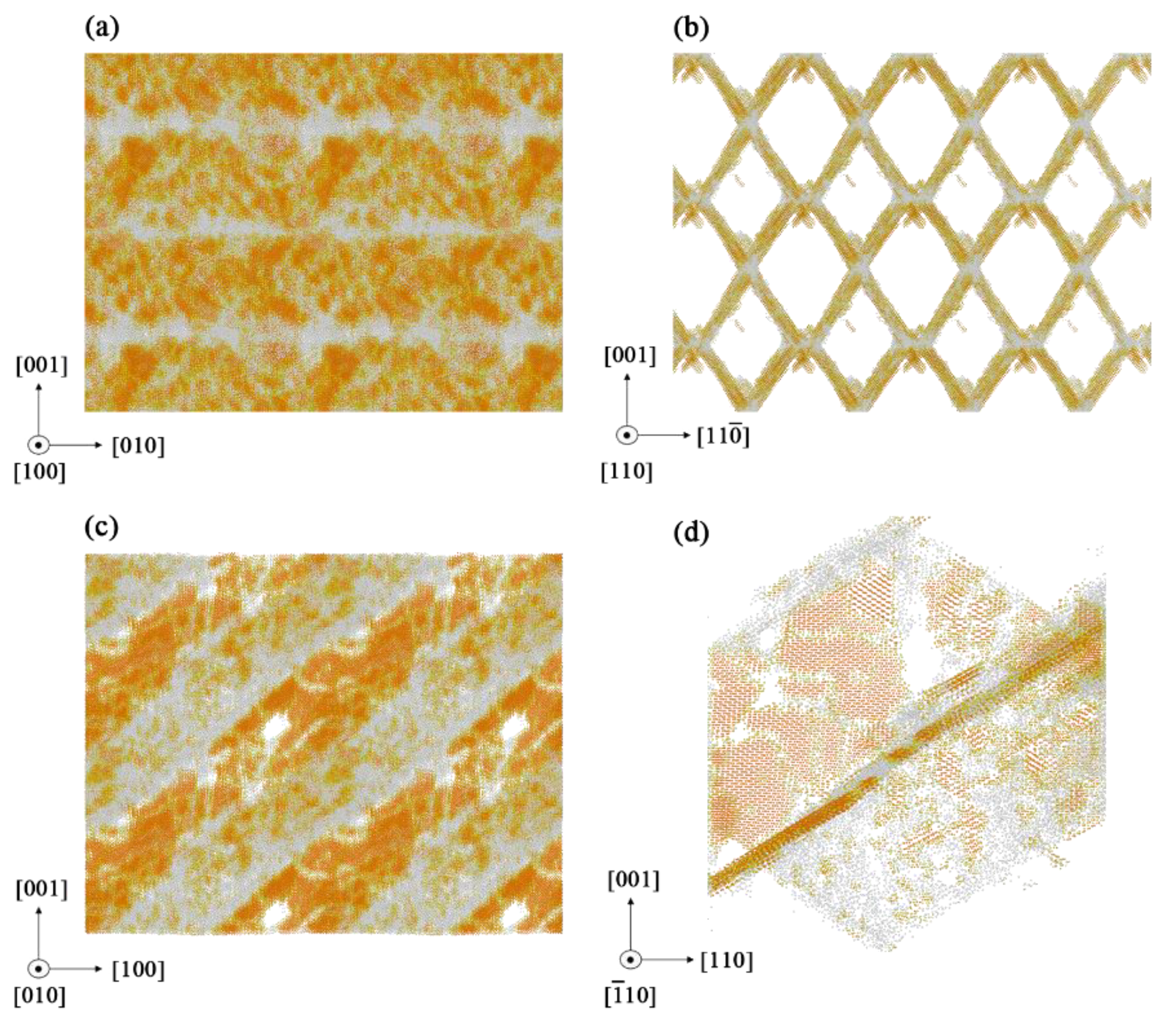
| Specimen Identifier | Number of Deleted Atoms | Radius of Point Defect/nm |
|---|---|---|
| 1 | 0 | 0.000 |
| 2 | 1 | 0.0543 |
| 3 | 123 | 0.0815 |
| 4 | 281 | 1.086 |
| 5 | 2149 | 2.172 |
| 6 | 4229 | 2.715 |
| Specimen Identifier | Crystal Plane 1 | Crystal Plane 2 | Angle between Two Planes |
|---|---|---|---|
| 1 | 70.53° | ||
| 2 | 70.53° | ||
| 3 | 70.53° | ||
| 4 | 70.53° | ||
| 5 | 70.53° | ||
| 6 | 70.53° |
Publisher’s Note: MDPI stays neutral with regard to jurisdictional claims in published maps and institutional affiliations. |
© 2021 by the authors. Licensee MDPI, Basel, Switzerland. This article is an open access article distributed under the terms and conditions of the Creative Commons Attribution (CC BY) license (https://creativecommons.org/licenses/by/4.0/).
Share and Cite
Wan, W.; Tang, C.; Qiu, A.; Xiang, Y. The Size Effects of Point Defect on the Mechanical Properties of Monocrystalline Silicon: A Molecular Dynamics Study. Materials 2021, 14, 3011. https://doi.org/10.3390/ma14113011
Wan W, Tang C, Qiu A, Xiang Y. The Size Effects of Point Defect on the Mechanical Properties of Monocrystalline Silicon: A Molecular Dynamics Study. Materials. 2021; 14(11):3011. https://doi.org/10.3390/ma14113011
Chicago/Turabian StyleWan, Wei, Changxin Tang, An Qiu, and Yongkang Xiang. 2021. "The Size Effects of Point Defect on the Mechanical Properties of Monocrystalline Silicon: A Molecular Dynamics Study" Materials 14, no. 11: 3011. https://doi.org/10.3390/ma14113011




